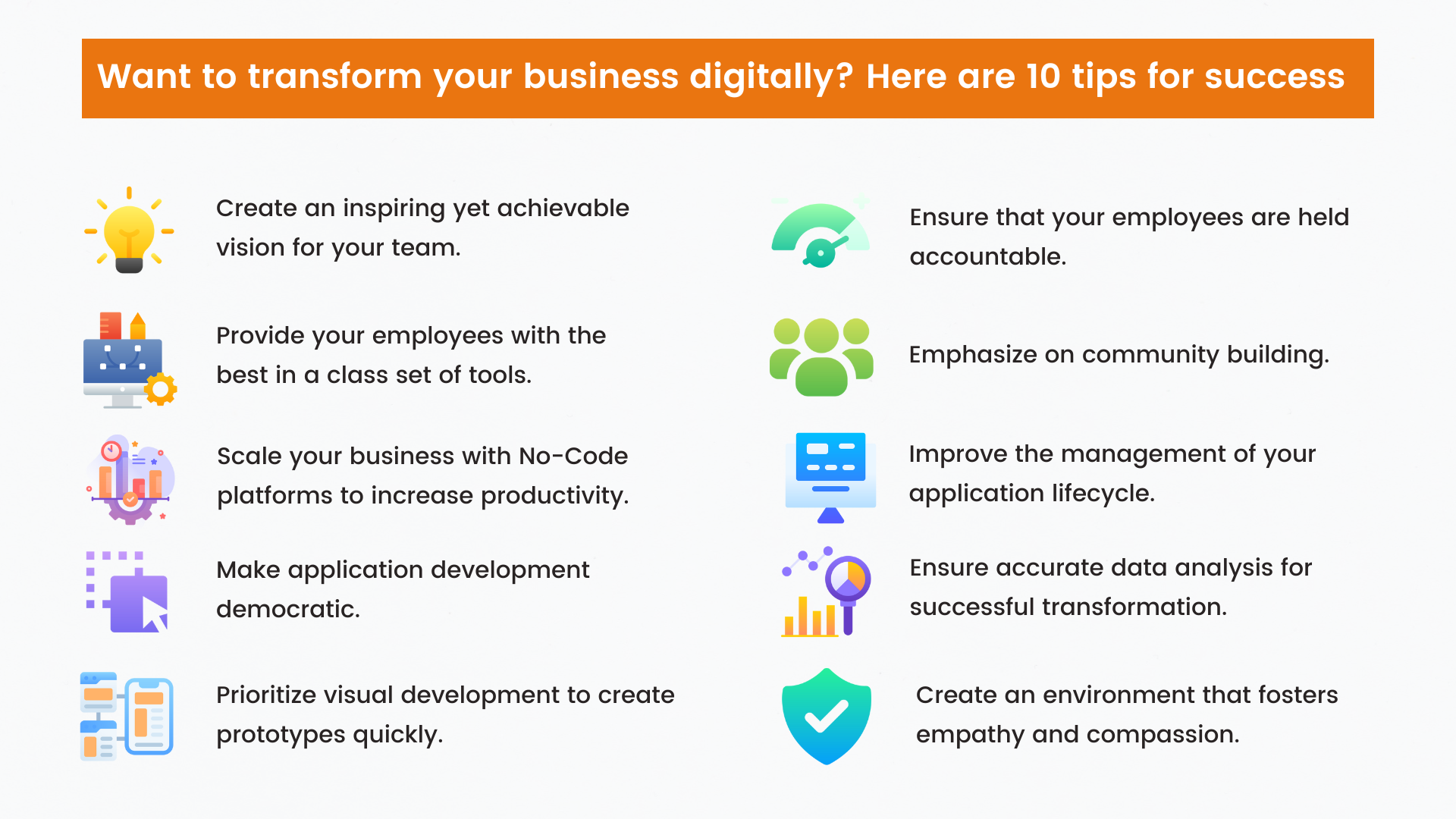
This article was first published on CustomerThink.
In most cases, digital transformation attempts face a lot of resistance and challenges. Here are some eye-opening numbers from International Data Corporation:
- Businesses will spend around $3.4 trillion on digital transformation projects by 2026.
- These investments are slated to have a 30% chance of success.
Successful Digital Transformation Tips
In order to ensure that your digital transformation project is a success, you should consider the following tips!

1. Create an enticing but feasible vision
Inspire everyone in your organization by sharing a believable, straightforward, and practical digital transformation vision. Outline where you’re heading, why you’re heading there and how this will influence your organization, customers, and workforce.
What do you hope to gain by participating in this project? Do you have a particular portion of your organization that you wish to keep safe? Tell them this story in various ways and multiple times until it becomes their narrative.
2. Provide your employees with the best in a class set of tools
You should follow proven processes to choose the best possible tools and platforms for your workforce. For example – to select the best fit no-code platform, you can first determine your focus goals. With no-code development, there is always a possibility of going overboard and therefore, having a list of focus goals can be of great help.
Some of your focus goals can be:
- Respond to business needs faster
- Innovate and get ahead of competitors
- Reduce costs and syntax errors
- Speed-up reporting/feedback
- Speed up data collection
- Better utilization of IT resources
3. Enhance your scalability
Many digital transformation projects are getting derailed due to:
- IT backlog
- Lack of quality IT talent
- Unavailability of no-code tools that can enable business users to build their applications
No-code development can assist your development team in getting more done in less time, thereby reducing backlogs and increasing productivity. You can leverage pre-built user interface components and visual building blocks to create priority-specific applications by using no-code platforms. An approach that relies on no-code reduces the time and effort required to scale and maintain applications across an entire company or for millions of customers.
Also Read: 80+ Digital Transformation Statistics and Trends To Help You Navigate
4. Make application development democratic
According to Gartner, the demand for business-related applications outpaces available IT capacity by five times.
As a result, a scarcity of qualified individuals is one of the most significant roadblocks to digital transformation. A substantial number of semi-technical employees can be transformed into citizen developers, allowing businesses to empower teams to produce high-quality digital solutions for day-to-day operations while still complying with IT security laws and resolving cybersecurity risks.
No-code development allows you to create applications, websites, workflows, and automation recipes using a simple user interface. A feature of some of the most polished low-code systems is the inclusion of backend connectors, allowing users to link their digital solution to various data sources and create one unified web portal.
Therefore, citizen developers can assist in accelerating the rise of corporate value while also increasing the availability of development resources. As they develop commercial applications, the IT department will be able to deal with the more complex digital challenges.
5. Make visual development a priority
You may significantly reduce the time it takes to develop new applications using technologies such as no-code (from well over six months to under four weeks). Because of the drag-and-drop functionality, both developers and non-developers may quickly create front-end applications on the move. When developing and testing functional prototypes of potential solutions, no-code platforms have a considerable advantage over traditional programming languages.
The adoption of no-code goods can be beneficial for business users familiar with and knowledgeable about operational challenges. To construct functional prototypes, they can use drag-and-drop interfaces, pre-configured links to data sources and APIs, and built-in security. Many boilerplate tasks have been completed, resulting in most no-code app development projects being completed with little to no coding.
6. Ensure that your employees are held accountable
Include them in their performance contracts and provide the proper weighting to the assignments to ensure that your staff prioritize their responsibilities. Employees are unable to manage these responsibilities effectively from their desks. If you want your employees to take your digital transformation journey seriously, you must demonstrate that you value their roles, obligations, and contributions consistently.
This allows you to recognize and reward your employees’ efforts and ensure that their performance contracts include this information.
Also Read: Crafting A Winning Digital Transformation Strategy: 7 Key Components
7. Emphasize community building
Create opportunities for individuals to interact with other position holders and provide them with the tools they need to succeed in their present position. Make it possible for them to communicate with one another to handle similar problems and continue to share skills through working groups. As a courtesy, request that they report back to the committees or steering groups supervising your digital transformation on their progress and issues.
Professionals who work with comparable data, such as risk, finance, or consumer data, will be brought together as part of this initiative. Don’t underestimate the value of insights gained from multiple data sets. To oversee all information management of jobholders, activities, and industries, it is necessary to establish an Information Management Forum or Committee.
8. Improve the management of your application lifecycle
The primary goal is to produce applications that are simple to scale, cost-effective, and can be developed in a short period. As an alternative to relying on DevOps or engineering teams, no-code development can help you improve the pace with which applications are delivered by allowing users to launch applications with a few clicks.
Use a platform that allows you to perform everything in real-time. You can complete all phases of the application life cycle in one place, ensuring security and compliance while also maintaining version control and other features.
Suppose a company’s software maintenance phase is to be successful. In that case, the ability to quickly update what has already been produced is critical for ensuring that the app continues to meet its customers’ needs.
9. Make sure your data is accurate
Financial and consumer data analysis is routine in the business world, sometimes even occurring daily. Every piece of information should be addressed in the same way, with regular reviews. The most crucial goal here is to ensure that you have accurate data at every process stage. To drive your digital strategy, the quality of your data is directly tied to the quality of the insights you derive from it.
Data quality reports should be reviewed daily to identify gaps, and you should engage your IM role holders to close those gaps. Then the reports should be reviewed again. Obtaining high-quality data and hence high-quality insights do not happen by accident.

10. Create an environment that fosters empathy and compassion
Make sure to give your employees enough time to acclimate to digital transformation demands and determine how well they fit into their present responsibilities. Allow time and space for discussions to assist everyone in reaching a common understanding of the situation.
We believe that the advice provided above will assist you in realizing your digital transformation goals, remaining relevant, and preparing for the future’s unknowns.
Also Read: Digital Transformation vs. Digital Modernization: Which is Better for You?
Conclusion
Every company has jumped on the digital transformation bandwagon, but studies show that more than 70% of these projects fail. Why? Because of poor planning and execution. Keep the above ten tips in mind while executing your project to prevent your digital transformation from becoming an expensive mistake.
Subscribe
Login
Please login to comment
0 Comments
Oldest
















